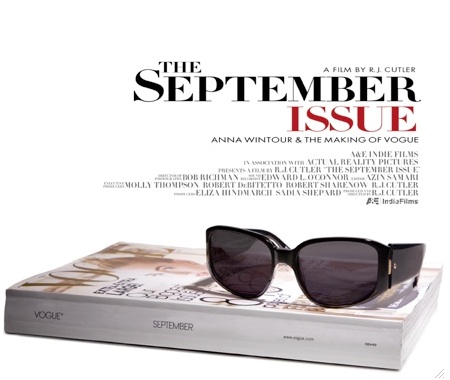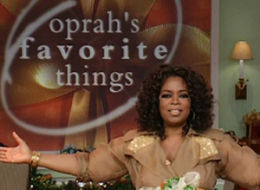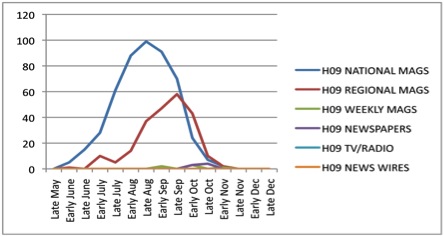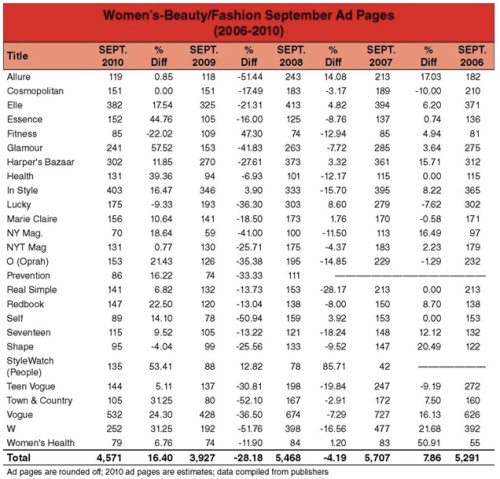E! Network, Good Day LA & LA Times have RSVP’d to our California Style Media Event. The deadline is soon to meet them! http://bit.ly/dDcpdW
E! Network, Good Day LA & LA Times have all RSVP’d to our California Style Media Event. Will you be there to meet them? http://bit.ly/dDcpdW
Where do most consumers do their product research?
Published October 22, 2010 Uncategorized Leave a CommentOnline, of course. Send your product information to bloggers for extra coverage with a lot bang for the buck!
When searching for product reviews whether it’s technology, gadgets, the best lip gloss, or a blender, most people search online. Many sites have user reviews, but there are expert sites that rely exclusively on bloggers who make their living at reviewing products and blogging about them.
To pull off a great product launch, it’s in your best interest to get to know bloggers and tap into this easy-to-reach market.
Why is it often times easier to get product coverage from bloggers?
- Bloggers review products daily, having much shorter leadtimes than traditional print media.
- Experts in certain fields, say technology for example, are always actively looking for the latest finds.
- Many bloggers have threads where you can submit to them immediately through their site.
- First things first. You need to find the blogs that fit your product.
Which are fastest and easiest way to find the bloggers reviewing your product category?
- Perform a YouTube search for bloggers that review your product category and have a huge following.
- Perform a Google search using the blog function.
- Consult The Gift List for Web & Blog.
Have you signed up for our MediaBistro Webcast on Tuesday? Learn 20 tips to pitch your products to media…http://bit.ly/bVCZVc
Only a few days left for discounted registration to the Hundreds Under $100 event. Save hundreds! Offer ends 7/31. http://bit.ly/cW8B6E
 Advertisers have come back in droves for the September Issue. Do we have Anna Wintour’s documentary of the same name to thank? The answer is probably not. Last year’s September issue was the smallest across the board, but the trending back up was most likely do to the economy rebounding.
Advertisers have come back in droves for the September Issue. Do we have Anna Wintour’s documentary of the same name to thank? The answer is probably not. Last year’s September issue was the smallest across the board, but the trending back up was most likely do to the economy rebounding.
What does this mean for you? Because of the increase in ad pages, there’s also an increase in editorial content. Most magazines have a set ad to editorial ratio. The September issue is always the largest for fashion and beauty magazine, but the trend should continue. Since the growth is across the board, it’s a good sign that this trend will continue.
Media Bistro went through and counted pages for a few of the top Fashion & Beauty magazines. Here’s who topped their list:
VOGUE: 532 pages
INSTYLE: 403 pages
ELLE: 382 pages
HARPER’S BAZAAR: 302 pages
CHART BY MEDIA BISTROOprah Will Give Product Coverage A Boost
Published November 20, 2009 Media on the Move , Opportunity Knocks Leave a Comment Today Oprah went on air and announced that her 25th season of her talk show will be her last. Some people are broken up about it. And you’d think with her influence on consumers, we’d be upset that we are losing a major outlet for product coverage. But we don’t think so.
Today Oprah went on air and announced that her 25th season of her talk show will be her last. Some people are broken up about it. And you’d think with her influence on consumers, we’d be upset that we are losing a major outlet for product coverage. But we don’t think so.
Oprah is starting her own network, ironically called OWN, the Oprah Winfrey Network. And given what a product junkie she is, we think that there will be no shortage of shows featuring product coverage. Now we know we won’t be compensated by putting these ideas out there, but here’s a few product-driven show ideas we think would fit the OWN.
Show #1
My Favorite Things – a weekly show dedicated to Oprah’s favorite things.
Show #2
The 5 Books I Am Reading – a weekly show where Oprah interviews celebrities about the books they are reading and what they like about them.
Show #3
The O Book Club – Come on, this one is a no-brainer. This is pretty much already in existence, but will have it’s own hour each week. Housewives everywhere will be tucked in with a novel every night so that they can tune in to the book club show each weekend.
Show #4
Fitness 911 – It would be shocking if Bob Greene didn’t get his own show that would intervene in some fat person’s pathetic life each week, all while hocking his Best Life products.
Show #5
Makeover- This show is really titled: MAKE-OOOO-VVVVVV-EEEEEE-RRRRR. The show would feature frumpy moms made over in a segment that they’ll call “Dump The Frump”. Ali Wentworth could host.
Show #6
Past Repasts – Gayle will go find the fattening food she loves (corndogs at State Fairs) and will have a celebrity chef demonstrate how to transform it into a healthier option.
Show #7
Mark’s Guy Gadgets – Mr. Kelly Ripa showcases the latest guy gadgets for the metrosexual dad.
So don’t despair…There may be a lapse between Oprah’s show going off the air and the new network launch, but Oprah will still have a forum to influence housewives across the nation into buying fuzzy robes and expensive eye cream.
Spin to Get Google’s Attention
Published October 27, 2009 Uncategorized Leave a CommentTags: New Product Launch, Press Release Distribution
Writing a press release about the launch of a new product? If you follow standard protocol, you know all the little rules about writing a press release, i.e. one page, at least one quote, first sentence should provide a summary of the whole release, etc. But writing a press release for the web is a bit different. Most press release distribution sites aren’t scanned by journalists looking for a big story. The purpose of the press release distribution sites is really to get more content onto the web about your product and to improve your organic ranking when people do a google search.
For example, check out this press release on Pork. We came across it during one of our sweeps of Google News Alerts. At first, we couldn’t figure out why a press release on pork would have shown up in our inbox. But looking closer, the tags that Google picked up were all about consumer magazines and increased circulation. So think about it. Are your press releases being seen by the people you want to see them? If not, then perhaps you aren’t spinning it the right way. Here’s a handy little checklist for writing press releases for the web:
• Identify your target audience and write directly to them.
• Use keywords and keyword phrases that your target audience would use to search for to find this product.
• Provide at least 2 or 3 links that go back to different pages on the website.
• Think outside the box.
Look at the press release on advertising the pork industry that we mentioned. Did they attract their target? Perhaps. We will never know. But it got a quick look from us. And we are betting that an editor or two got it in their Google News Alerts. What they do with it now is up to them.
Media Coverage: To leverage or not to leverage.
Published September 28, 2009 Perfect Pitch , Uncategorized Leave a CommentThat is the question.
What is the answer? Yeah or nay?
You secured coverage for your product in a publication or on the news. Congrats! Now the dilemma…is it okay to leverage that coverage into more coverage in other media outlets? The quandary is that you’d love editors to know the buzz that your product has received, yet some editors are turned off by clips in competing magazines.
We polled a few editors and publicists and got their advice on when to use clips from other publications and when not to. For these examples, we are using the imaginary Scrub-a-Dub organic soap, made by a small start-up company.
Yeah or Nay? Yeah. You could pitch this to local and regional publications and actually craft the pitch as ” Scrub-a-Dub, a local start-up organic soap-maker gets chosen as one of Oprah’s favorite things for the holiday.
Rule of Thumb: If the recognition is so large that it’s a story in itself, then pitch it. Be careful to only pitch this type of story to local or regional outlets and not large national outlets that would compete with the other outlet that’s already covered it.
Case #2: Scrub-a-Dub is featured in several women’s publications included Lucky* and Glamour*, and you’d like to get it into Marie Claire*
Yeah or Nay? Nay. Don’t send editors at Marie Claire clips of the coverage in Lucky or Glamour. One editor told us, “This is a total turn-off when I see that the product has been featured in magazines that are our direct competition or have the same demographics as us.”
Rule of Thumb: Editors want to provide their readers with fresh new finds, not a product that has over-exposure.
Case #3: A newspaper reporter has decided to do a business story on Scrub-a-Dub and wants to profile the owners on how they followed their passion to create the product.
Yeah or Nay? Yeah. When a story is being written in a completely different type of outlet–in a business section rather than a woman’s consumer magazine–then the newspaper reporter will often actually use the clips as background information and mention the successes that the business has had in media recognition.
Rule of Thumb: If the previous coverage will help the reporter with information about the client, and isn’t the same type of coverage, then it may be helpful to ask the reporter if they’d like to have clips of previous coverage.
Case #4: You’ve gotten several big hits including a snippet in Self Magazine*, a product review in Allure*, a celeb endorsement in OK* magazine and now you’d like to put it all on the product website under “media coverage” or “press links.”
Yeah or Nay? It depends. Not the easiest answer with this one. One publicist said ‘yeah’ because it builds credibility amongst your customers. Another said ‘nay’ but only during the initial launch of the product, so that seeing what others have done recently doesn’t turn off editors at competing magazines.
Rule of Thumb: If you are in the midst of a major PR campaign and launch, then you should probably keep media coverage under wraps. But if you have an established brand and are working on new products, then its fine and helpful to your customers to see that your brand is popular and getting a lot of buzz.
Case #5: A local city lifestyle magazine is covering your product launch and the other competing city magazine calls you for inclusion. Do you tell the editor that you are being covered elsewhere?
Yeah or Nay? Don’t lie. If they ask you if their competition has done anything on the product, then mention they are planning it for an upcoming issue. But if they don’t ask, you do not have no to disclose the information, as long as you are aware that there may be consequences. One such editor told us, “I recently assigned an interview with a local expert on a new product launch and after the magazine had gone to the printer, I opened the competition and saw the same type of article.” The editor wasn’t happy, but admits she didn’t ask for an exclusive, however, she would have appreciated knowing about it so that her magazine didn’t look bad by having an old story by the time it hit newsstands. She might think twice before she trusts the publicist or client in the future.
Rule of Thumb: Be honest and know the consequences. Competing editors often have very contentious relationships, especially in local publications. If you want to have a good ongoing working relationship with them, it’s best to be up-front. If you aren’t up-front, they may not offer coverage in the future.
Tallying the votes…
Hopefully these case studies will help you navigate the do’s and don’ts when it comes to sharing coverage with editors. As with any rule of thumb, there’s always the exception, but the consensus that we found amongst the editors and publicists that we pulled was this one rule of thumb: It’s all about size.
The big fish don’t want to know about each other and the little fish want to keep up with the big fish. So the bigger the publication, the less likely they’ll be favorable to seeing other media coverage. The smaller the publication, the more they’ll be impressed with the national exposure your product has received.
*All mentions of publications are for examples and are not meant to express their opinions or preferences.
Never assume that it is too late to secure editorial coverage!
Sure, we post deadlines for a reason. Editors give them to us. But, we constantly find outlets throughout the pitching season that are still in search of the next best thing.
There are several things to keep in mind when pitching for the holidays…
- Persistence pays off.
- The Gift List can be used continually through the season to identify and secure editorial possibilities.
- You should be flexible with your schedule and expectations in order to work with demanding editors.
The Holiday Pitching Season

The Gift List for Holiday 2008 Deadlines.

The Gift List for Holiday 2009 Deadlines, data collection to-date as of September 1, 2009
*You can see by comparing the graphs, that the shake-up in the media world that took place during the fourth quarter of 2008 has really pushed deadlines this year. Data collection at the time of gathering numbers for the 2009 graph had not begun for all outlet groups, which is why they are not all represented in the 2009 graph.
May/June
We start posting long leads including national high-circulation consumer magazines in early May. National magazines are shown in blue on the graph.
As you can see by the graph, the season starts off slowly with only a few publications seeking information with a 7-month lead-time. There are a couple of reasons a magazine might need a long lead time, such as sending products out to a panel of readers, developing recipes in a test kitchen or holding focus groups.
These very early deadlines oftentimes are not the most obvious outlets, for example this year Fit Pregnancy, Skywest Magazine and All You all had June deadlines.
July
Long leads continue to be posted as editors begin to collect submissions for their holiday issues. Deadlines start extending into August and September as editors try to hone down a focus for their holiday gift guides and feature focuses.
As you can see by the graph, this will be your busiest time for national magazines. Examples of July deadlines are Playboy, Ladies Home Journal, InStyle, Self, Glamour, Family Circle and so on.
Deadlines for regional magazines also start in July, such as Midwest Living and Los Angeles Magazine.
August & September
Regional magazines start making decisions on their editorial calendars for holiday features and gift guides. Deadlines generally range from July to October, peaking in September. Regional magazines are shown in red.
National weekly magazines such as People and US Weekly start making editorial decisions for holidays and set deadlines in September through November. Deadlines generally range from September to December, peaking in early November. Weekly magazines are shown in green.
News Wires and Syndicates are the next category to make an appearance. Early deadlines may include outlets such as Copley or Associated Press. News Wires and Syndicate deadlines start in early September, peaking in November. News Wires and Syndicates are shown in orange.
October
Newspaper special sections are planned and the majority post deadlines in October for Thanksgiving-related content and November for Christmas and Gift Guide content.
Daily newspapers have a short period of time when they collect product information. Generally it is from early October to late November, peaking in early November. If you had all your newspaper pitches ready to ship on November 1 you would be in good shape.
November
Local and regional newspapers start making decisions on content for holiday gift features. Radio and television shows start looking for submissions for holiday broadcasts.
December
Newspapers, radio, broadcast and online editors continue to look for last-minute gift ideas and the latest trends to include in shows, features, blogs and newsletters.
